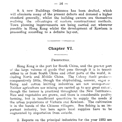
- Textile Quotas Legislation (1937)
This document is extracted from the Report of the Hong Kong General Chamber of Commerce for the year 1937. Since 1937, it was a rule that Hong Kong textile manufacturers had to prove their textile goods be spun, woven and finished within the British Empire in order to exempt from the quota restrictions on exporting the goods to the British Empire markets.

- Empire Quota for Textiles and Rayon Goods (1934)
This document is extracted from the Report of the Hong Kong General Chamber of Commerce for the year 1934. The Board of Trade in London suggested to the governments of all colonies and protectorates to introduce a system of quotas in order to protect British traders against competition of Japanese manufactured goods. The Chamber of Commerce reported its argument against this suggestion.

- Quantities and Values of Principal Articles of Exports During the Years 1937 and 1938
The report is extracted from the administrative report of "Commerce" for the year 1938. It recorded the exports from Hong Kong of both Chinese commodities and Hong Kong manufactured goods. Two tables were provided: (1) A table showing the value of the export of Hong Kong made goods in 1938; (2) Appendix C showing the percentage of total exports sent to the British Empire markets and foreign countries.

- Percentage of Total Exports sent to Empire and Foreign Countries (1939)
The report was extracted from the administrative report of "Commerce" for the year 1939. It recorded the exports from Hong Kong of both Chinese commodities and Hong Kong manufactured goods. Two tables were provided: (1) A table showing the value of the export of Hong Kong made goods in 1939; (2) Appendix C showing the percentage of total exports sent to the British Empire markets and foreign countries.

- Production (1932)
The report was originally under the section of Production of the Administrative Reports for the year 1932. It reported on the condition, performance, and import and export trends of selected industries in the year. It also provided factors that affected the performance of some industries. For example, import duty in China was cited as a factor that hit the production of refined sugar in Hong Kong; world economic depression continued to hit the demand of preserved ginger from Hong Kong; and unfavourable currency exchange had adverse effect on knitting production. From 1931 to 1937, this heading continued to appear in the government administrative reports.

- Production (1933)
The report was originally under the section of Production of the Administrative Reports for the year 1933. It reported on the condition, performance, and import and export trends of selected industries in the year. It also provided factors that affected the performance of some industries. For example, Chinese import tariff hit sugar refining and knitting industries in Hong Kong, whereas the Imperial Preference system encouraged export shipment of Hong Kong's rubber shoes to the British Empire markets. From 1931 to 1937, this heading continued to appear in the government administrative reports.

- Production (1935)
The report was originally under the section of Production of the Administrative Reports for the year 1935. It reported on the condition, performance, and import and export trends of selected industries in the year. It also provided factors that affected the performance of some industries. For example, floods in the Yangtsze Valley and Yellow river areas aggravated the economic condition in China and hit the demand of refined sugar from Hong Kong. Political instability in North China and fluctuations in current exchange rates had also hit the sugar refining industry in Hong Kong. From 1931 to 1937, this heading continued to appear in the government administrative reports.

- Production (1937)
The report was originally under the section of Production of the Administrative Reports for the year 1937. It reported on the condition, performance, and import and export trends of selected industries in the year. It also provided factors that affected the performance of some industries. For example, Japanese hostilities in China led to a decrease of the demand of Hong Kong's refined sugar in China and the block of supply of raw materials for cement production in Hong Kong. The Imperial Preference promoted the export of Hong Kong's knitted and woven goods, batteries and lard to the British Empire markets. From 1931 to 1937, this heading continued to appear in the government administrative reports.

- Imperial Preference (1932)
This document is extracted from the Report of the Hong Kong General Chamber of Commerce for the year 1932. In regard of manufacturing industries in Hong Kong, the Chamber suggested that Hong Kong industrial products that fit the requirement under United Kingdom Import Duty Act should be exempted from duty. This suggestion was made in response to the new Ottawa Conference Agreement that goods manufactured by materials grown or produced or from work done with a part of the British Empire are given preferential treatment on importation into the United Kingdom.

- Imperial Preference (1933)
This document is extracted from the Report of the Hong Kong General Chamber of Commerce for the year 1933. In regard of manufacturing industries in Hong Kong, the Chamber of Commerce had surveyed the industries in Hong Kong qualified for Imperial Preference in respect of costs in processing and work done in Hong Kong while the raw materials were imported from China. Industrial products that were not exported to the United Kingdom did not have encountered problems on meeting Imperial Preference requirements.
